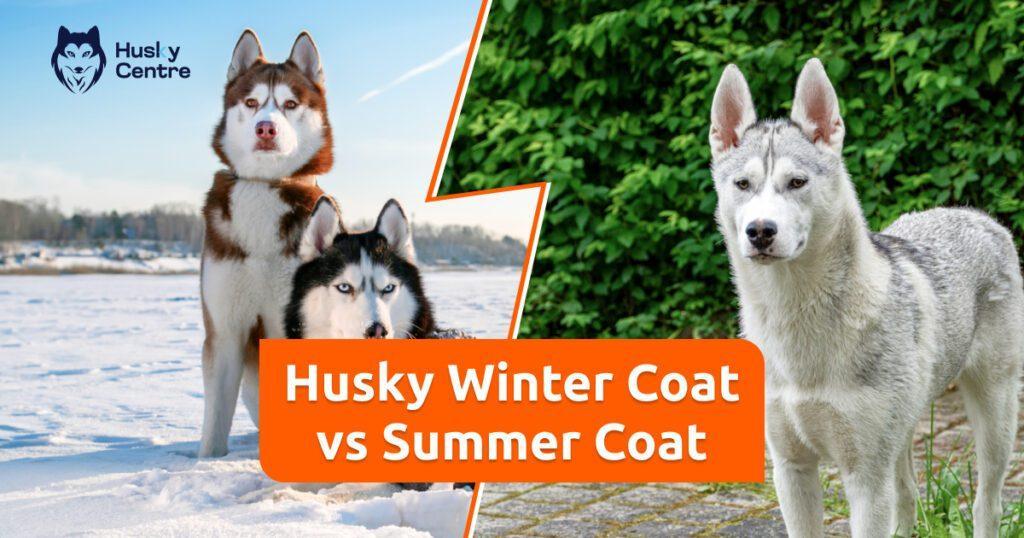Huskies have a double-layered coat for insulation against extreme weather. In winter, the undercoat thickens for warmth, while in summer, it sheds to keep the dog cool.
🐾 As a husky owner, understanding how your dog’s coat adapts to seasonal changes is crucial for their well-being. The breed’s unique double-layered fur serves as a natural defense against harsh weather conditions, making them well-equipped for both winter and summer.
During the colder months, their undercoat thickens to provide vital insulation, ensuring the husky stays warm in low temperatures. Conversely, as summer approaches, the undercoat sheds, allowing for better air circulation and preventing the dog from overheating.
This natural adaptation ensures your husky remains comfortable and healthy throughout the year. By recognizing these seasonal variations, owners can proactively support their husky’s natural coat regulation, ensuring their pet’s optimal health and comfort.
Winter Coat Essentials
Discover the ultimate winter coat essentials and the differences between a husky’s winter coat and summer coat. Understand the importance of choosing the right coat for your husky to keep them comfortable and protected in various weather conditions.
Winter Coat Essentials
When it comes to preparing your husky for the cold winter months, a reliable winter coat is essential to help keep them warm and protected. Choosing a coat with insulating properties and water-resistant features is key to ensuring your furry friend stays comfortable and safe during the chilly season.
Insulating Properties
Huskies have a double coat, consisting of a dense undercoat and longer guard hairs, which naturally provides excellent insulation against the cold. When selecting a winter coat, it’s important to look for materials that offer additional insulation.
Opt for coats lined with materials like fleece or down, as they provide superior warmth without adding excessive bulk.
Water-Resistant Features
In snowy and wet conditions, a water-resistant winter coat is crucial to keeping your husky dry and preventing their fur from becoming waterlogged. Look for coats made from breathable, waterproof materials to ensure they stay comfortable and dry, even during outdoor activities in the snow.
In conclusion, when choosing a winter coat for your husky, prioritize insulation and water-resistant features to ensure they stay warm, dry, and happy during the colder months.
Summer Coat Needs
A Siberian Husky’s coat plays a vital role in regulating their body temperature. While their thick winter coat provides insulation in colder months, their summer coat serves a different purpose. Understanding the specific needs of a husky’s summer coat is essential to ensure their comfort and well-being in warmer weather.
Cooling Ability
The primary function of a husky’s summer coat is to help them cool down in hot temperatures. Unlike their dense winter coat, the summer coat is lighter and allows for better airflow, enabling the dog to dissipate excess heat.
The outer guard hairs of the summer coat are typically shorter, thinner, and sparser compared to the winter coat. This allows the air to reach the dog’s skin more easily, promoting evaporation of sweat and facilitating efficient cooling.
Protection From UV rays
Another essential aspect of a husky’s summer coat is its ability to provide protection from harmful UV rays. The coat acts as a barrier, shielding the dog’s sensitive skin from the sun’s damaging effects.
The dense fur of a husky’s winter coat offers natural protection against UV rays by blocking a significant amount of sunlight. However, during the summer, when their coat becomes thinner, the dog’s skin becomes more exposed and susceptible to sunburn and sun damage.
To ensure their safety, it is advisable to limit the husky’s exposure to direct sunlight during peak hours and provide shade when possible. Additionally, applying pet-safe sunscreen to exposed areas, such as the nose and ears, can offer extra protection against harmful UV rays.
Adaptability To Climate Changes
Huskies are known for their thick double coats that help them survive in extreme climates. Their winter coat is designed to keep them warm and protected from the harsh cold, while their summer coat is lighter and allows for better ventilation.
The adaptability of their coat is crucial for their overall well-being and comfort. In this article, we will explore how huskies transition from their winter to summer coat and vice versa, ensuring they are prepared for the changing seasons.
Transitioning From Winter To Summer
As the winter season comes to an end, huskies undergo a natural process of shedding their thick winter coat. This shedding process is triggered by the increase in daylight hours, signaling to their bodies that it’s time to prepare for warmer weather.
During this transition, huskies may lose a significant amount of fur, which can be a cause for concern for some owners.
However, this shedding is completely normal and necessary for huskies to adapt to the changing climate. Their winter coat is replaced with a lighter summer coat that allows for better air circulation, helping them stay cool in the rising temperatures.
The shedding process may last for several weeks, and regular brushing is essential to help remove the loose fur and prevent matting.
Adjusting From Summer To Winter
As the summer comes to an end and the temperatures start dropping, huskies begin to grow their winter coat to prepare for the cold weather ahead. This process is influenced by changes in daylight and temperature, signaling the body to start producing thicker fur.
The new coat consists of a soft undercoat and a coarser outer layer, providing insulation and protection against the freezing temperatures.
During this adjustment period, it is important to monitor your husky’s fur growth. Ensuring their coat is growing evenly and without any abnormalities can help prevent issues such as matting or skin irritations.
Regular brushing is necessary to keep the coat clean and free of tangles, as a well-groomed coat provides better insulation and protection during winter.
Grooming And Maintenance
The husky’s winter coat is thick and provides insulation against the cold, while the summer coat is lighter and sheds more. Grooming and maintenance help manage the shed fur, promoting overall health and comfort for the husky in both seasons.
Regular brushing and a balanced diet can aid in maintaining their coats.
Grooming and maintenance are essential aspects of caring for your beloved Husky’s coat throughout the year. Understanding how to properly groom and maintain the winter and summer coats of your furry friend will not only keep them clean and comfortable but also help them stay healthy.
Here are some important tips to keep in mind when it comes to grooming and maintaining your Husky’s seasonal coats.
Seasonal Coat Care Tips
Huskies have unique coats that are specifically designed to protect them from extreme weather conditions. During the winter months, their coats become thicker and denser, providing insulation and keeping them warm. On the other hand, in the summer, their coats become lighter and thinner, allowing better airflow and preventing overheating.
To ensure your Husky’s winter coat remains in top shape, regular brushing is crucial. This helps to remove any loose fur and prevents matting, which can lead to skin irritations and discomfort. A slicker brush or an undercoat rake is perfect for effectively removing the dead hair from their thick winter coat.
During the summer months, your Husky’s coat requires a different approach. While they shed less during this time, regular brushing is still important to keep their coat clean and healthy. Using a brush with soft bristles or a shedding tool can effectively remove any loose fur, preventing it from becoming tangled and causing potential skin issues.
Another important aspect of grooming your Husky’s coat is bathing. During the winter, bathing should be kept to a minimum to avoid stripping the natural oils that keep their coat insulated and protected.
However, during the summer, more frequent bathing can help keep them cool and remove any dirt or debris that may accumulate.
Potential Health Concerns
While grooming and maintaining your Husky’s coat is essential, it’s also important to be aware of potential health concerns.
One common issue is hot spots, which can occur during the summer due to increased moisture and heat. Regular grooming and keeping their coat clean and dry can help prevent hot spots from developing.
Another concern is fleas and ticks, which can affect your Husky regardless of the season. These parasites can cause discomfort and health issues, so it’s crucial to maintain a regular flea and tick prevention routine. Consult your veterinarian for appropriate flea and tick treatments.
Remember, consistent grooming and maintenance practices are key to ensuring your Husky’s coat remains healthy and beautiful throughout the year.
Understanding their seasonal coat care needs and addressing them accordingly will help your furry friend stay happy, comfortable, and free from any potential health issues.
Choosing The Right Coat For Your Husky
If you have a Husky and live in a region with distinct seasons, it’s important to consider the unique needs of your furry friend when it comes to their coat.
Huskies are known for their thick, luxurious fur, which keeps them warm in the winter and protects them from the sun during the summer.
Factors To Consider
When deciding on the perfect coat for your Husky, there are several factors to consider:
- The climate of your region
- Your Husky’s activity level
- The quality and density of your Husky’s natural fur
The climate of your region plays a crucial role in determining the type of coat your Husky needs. If you live in a cold environment with harsh winters, you’ll want to ensure your Husky has a thick, insulated coat to keep them warm.
On the other hand, if you reside in a warmer climate with hot summers, a lighter coat that allows for better airflow and UV protection will be essential.
Your Husky’s activity level is another crucial factor to consider. If your Husky is highly active, participating in activities like running or hiking, they may generate more body heat and require a coat that offers better breathability and moisture-wicking properties.
Conversely, if your Husky is more sedentary, a thicker, plush coat may be better suited to keep them warm and cozy.
The quality and density of your Husky’s natural fur also play a role in choosing the right coat. Some Huskies naturally have a thicker coat, while others may have a finer, less dense coat.
If your Husky has a naturally thick coat, a lighter and less insulated coat may be sufficient. However, if your Husky has a less dense coat, a coat with more insulation will be necessary to provide adequate warmth.
Professional Recommendations
Professionals recommend considering the following when selecting a coat for your Husky:
- Opt for a coat made from high-quality materials that are both durable and breathable. Look for coats with adjustable straps and secure closures to ensure a snug fit.
- Consider purchasing a coat that offers protection against UV rays and is easy to clean. This will help protect your Husky’s skin from sunburn and make maintenance a breeze.
- Consult with your veterinarian or a professional dog groomer to determine the most suitable coat for your Husky based on their specific needs and characteristics.
Taking the time to choose the right coat for your Husky will not only help keep them comfortable throughout the year, but also ensure their overall health and well-being.
By considering the factors mentioned above and following professional recommendations, you can make an informed decision and provide your Husky with the ideal coat for any season.
Frequently Asked Questions For Husky Winter Coat Vs Summer Coat
What Is The Difference Between A Husky’s Winter Coat And Summer Coat?
A husky’s winter coat is thick and dense, providing insulation and protection against the cold. In contrast, the summer coat is lighter and sheds fur to stay cool in warmer temperatures.
How Does A Husky’s Coat Adapt To Different Seasons?
The husky’s coat is designed to adapt to changing seasons. In winter, the undercoat grows thicker, providing warmth. In summer, it sheds excess fur to keep the dog cool and prevent overheating.
Can I Shave My Husky During The Summer?
Shaving a husky’s coat is not recommended during the summer. The double coat acts as insulation against the heat and protects the dog’s skin from harmful UV rays. Instead, regular brushing will help remove excess fur and keep the dog cool.
Do Huskies Need Coats In The Winter?
Huskies have a naturally thick winter coat that is usually sufficient to keep them warm in cold temperatures. However, in extreme cold conditions or for older huskies, a coat or sweater can provide additional warmth and protection.
Conclusion
To sum it up, huskies’ winter and summer coats serve specific purposes. Their thick winter coat acts as a protective shield against the cold, while the lighter summer coat helps them stay cool in warmer temperatures. Understanding the difference allows us to provide appropriate care and ensure their comfort throughout the year.
So, keep in mind the unique needs of your husky’s coat to keep them healthy and happy in any season.


Meet Jarred, the heart and soul behind HukyCentre. With a deep affection for furry friends, he pours his passion into every word he writes. His genuine love for dogs shines through in his engaging and informative content. As a dedicated dog enthusiast, Jarred’s goal is to share valuable insights and tips that resonate with fellow dog lovers. Join Jarred on the journey as he celebrates the joy and companionship that dogs bring into our lives.



